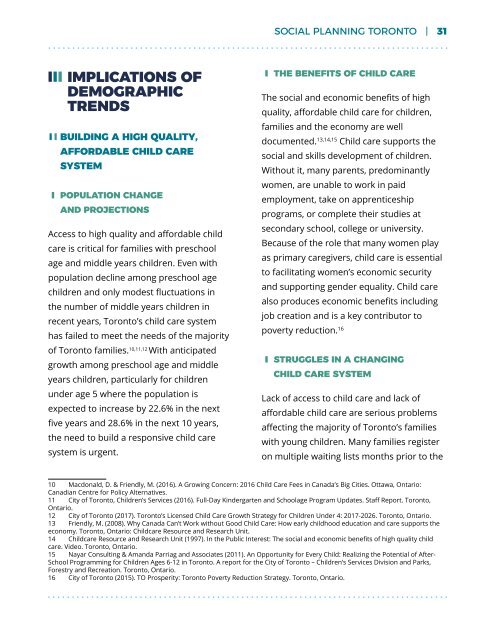Demographic Change in Toronto's Neighbourhoods
You also want an ePaper? Increase the reach of your titles
YUMPU automatically turns print PDFs into web optimized ePapers that Google loves.
SOCIAL PLANNING TORONTO | 31<br />
IMPLICATIONS OF<br />
DEMOGRAPHIC<br />
TRENDS<br />
BUILDING A HIGH QUALITY,<br />
AFFORDABLE CHILD CARE<br />
SYSTEM<br />
POPULATION CHANGE<br />
AND PROJECTIONS<br />
Access to high quality and affordable child<br />
care is critical for families with preschool<br />
age and middle years children. Even with<br />
population decl<strong>in</strong>e among preschool age<br />
children and only modest fluctuations <strong>in</strong><br />
the number of middle years children <strong>in</strong><br />
recent years, Toronto’s child care system<br />
has failed to meet the needs of the majority<br />
of Toronto families. 10,11,12 With anticipated<br />
growth among preschool age and middle<br />
years children, particularly for children<br />
under age 5 where the population is<br />
expected to <strong>in</strong>crease by 22.6% <strong>in</strong> the next<br />
five years and 28.6% <strong>in</strong> the next 10 years,<br />
the need to build a responsive child care<br />
system is urgent.<br />
THE BENEFITS OF CHILD CARE<br />
The social and economic benefits of high<br />
quality, affordable child care for children,<br />
families and the economy are well<br />
documented. 13,14,15 Child care supports the<br />
social and skills development of children.<br />
Without it, many parents, predom<strong>in</strong>antly<br />
women, are unable to work <strong>in</strong> paid<br />
employment, take on apprenticeship<br />
programs, or complete their studies at<br />
secondary school, college or university.<br />
Because of the role that many women play<br />
as primary caregivers, child care is essential<br />
to facilitat<strong>in</strong>g women’s economic security<br />
and support<strong>in</strong>g gender equality. Child care<br />
also produces economic benefits <strong>in</strong>clud<strong>in</strong>g<br />
job creation and is a key contributor to<br />
poverty reduction. 16<br />
STRUGGLES IN A CHANGING<br />
CHILD CARE SYSTEM<br />
Lack of access to child care and lack of<br />
affordable child care are serious problems<br />
affect<strong>in</strong>g the majority of Toronto’s families<br />
with young children. Many families register<br />
on multiple wait<strong>in</strong>g lists months prior to the<br />
10 Macdonald, D. & Friendly, M. (2016). A Grow<strong>in</strong>g Concern: 2016 Child Care Fees <strong>in</strong> Canada’s Big Cities. Ottawa, Ontario:<br />
Canadian Centre for Policy Alternatives.<br />
11 City of Toronto, Children’s Services (2016). Full-Day K<strong>in</strong>dergarten and Schoolage Program Updates. Staff Report. Toronto,<br />
Ontario.<br />
12 City of Toronto (2017). Toronto’s Licensed Child Care Growth Strategy for Children Under 4: 2017-2026. Toronto, Ontario.<br />
13 Friendly, M. (2008). Why Canada Can’t Work without Good Child Care: How early childhood education and care supports the<br />
economy. Toronto, Ontario: Childcare Resource and Research Unit.<br />
14 Childcare Resource and Research Unit (1997). In the Public Interest: The social and economic benefits of high quality child<br />
care. Video. Toronto, Ontario.<br />
15 Nayar Consult<strong>in</strong>g & Amanda Parriag and Associates (2011). An Opportunity for Every Child: Realiz<strong>in</strong>g the Potential of After-<br />
School Programm<strong>in</strong>g for Children Ages 6-12 <strong>in</strong> Toronto. A report for the City of Toronto – Children’s Services Division and Parks,<br />
Forestry and Recreation. Toronto, Ontario.<br />
16 City of Toronto (2015). TO Prosperity: Toronto Poverty Reduction Strategy. Toronto, Ontario.
















